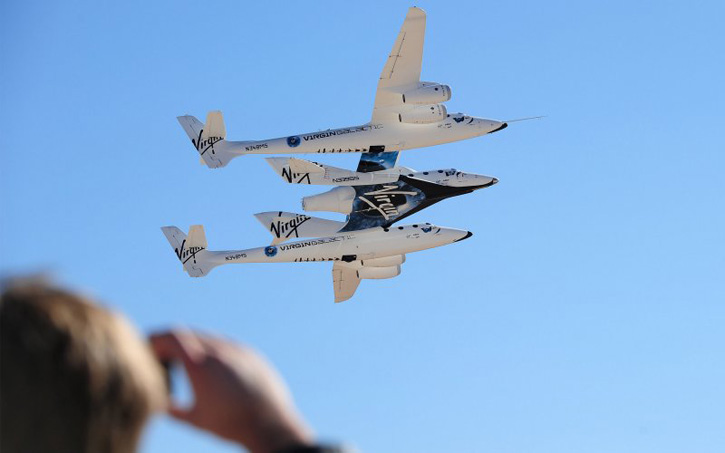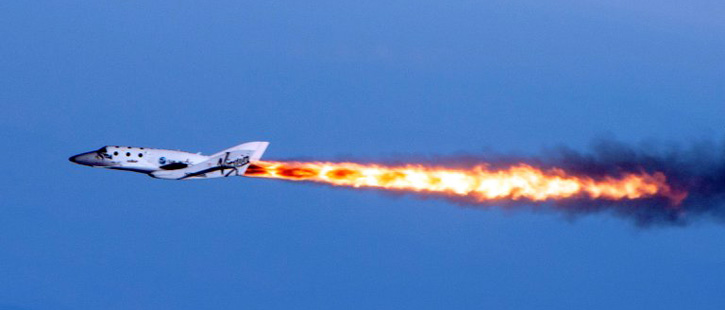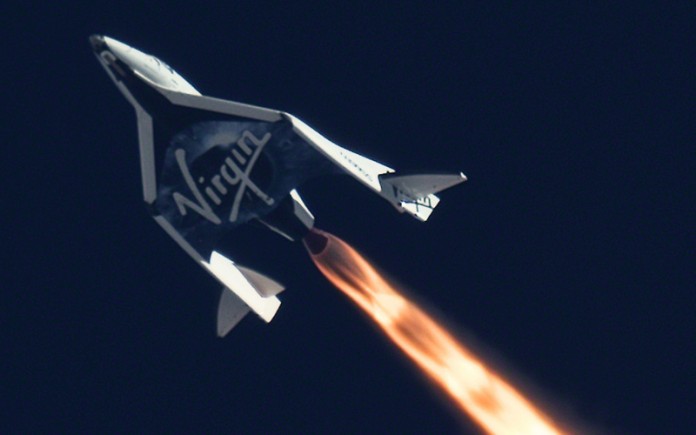


Virgin Galactic’sVirgin’s partner Scaled Composites conducted a powered test flight of SpaceShip Two (SS2) today over California. On that flight the vehicle broke apart after the rocket motor ignited, the vehicle crashed near Mojave. One of the two test pilots on board was killed, the second apparently escaped and is seriously injured, authorities said. The spacecraft exploded at about 10:00 AM local time, shortly after the hybrid solid rocket motor was ignited, after the rocket plane separated from its ‘mothership’ – WhiteKnightTwo at an altitude of about 50,000 ft. Both vehicles were developed by Mojave-based Scaled Composites, Virgin’s development partner on this program.
The cause of the fatal mishape is not known yet but investigators have recovered SpaceShipTwo’s propellant tanks and engine intact, indicating there was no explosion. At this stage, human error isn’t ruled out as SpaceShipTwo’s rotating tail boom, a key safety feature for re-entering the atmosphere, rotated early – investigators found.
Michael Alsbury, 39, has been identified as the co-pilot who died. Peter Siebold, the 43-year-old pilot riding in the right-hand seat, parachuted to the ground and was recovering at a nearby hospital, Scaled Composites said in a statement Reuters reported. Although the crew were equipped with parachutes, the pilot who was killed was found “still in seat,” AP reported. The other reportedly escaped and evacuated to a hospital. A day after the fatal accident Virgin Galactic founder Richard Barnson said the company will continue with its long running plans to become the world’s first spaceline (Aviation Week).
The tandem plane took off from the Mojave Air and Space port carrying the SS2 rocket plane to its initial ascend into the edge of space. On that mission SS2 was flight testing its rocket engine with a new propellant for the first time. It was the first time the space ship flew in more than nine months and the test team was hopeful to get the ship higher and faster than ever before. “We’re going to be shooting for increased burn duration on the next flight, when we get there,” Virgin Galactic CEO George Whitesides told NBC back in May.

This mishape was not the first fatality experienced with this program. In 2007 the developers experienced an explosion of a similar rocket engine running on HTPB. The explosion happened as the engine was attached to a test bench, killing three engineers that observing the test too closely. Virgin Space Ship Enterprise, the first of the new class conducted its first powered flight on 29 April 2013.
During that flight the engine burned for 16 seconds, taking the Enterprise from 47,000 ft to the height of 55,000 ft and speed of Mach 1.2. However, the rubber-based HTPB solid propellant experienced serious engine stability issues on firings longer than 20 seconds, thus required the use of alternative fuel.  During the past months Virgin Galactic switched SpaceShipTwo’s propellant to a thermoplastic polyamid grain based fuel mixture, to increase engine performance, improve efficiency and stability. With the new rocket installed, SpaceShipTwo was expected to fly more than five times higher than it had ever flown before. Although the Polyamid grain propelled rocket was tested on the ground for several times, today’s flight was the first powered flight for the motor.
During the past months Virgin Galactic switched SpaceShipTwo’s propellant to a thermoplastic polyamid grain based fuel mixture, to increase engine performance, improve efficiency and stability. With the new rocket installed, SpaceShipTwo was expected to fly more than five times higher than it had ever flown before. Although the Polyamid grain propelled rocket was tested on the ground for several times, today’s flight was the first powered flight for the motor.
Four weeks ago SpaceShipTwo made an unpowered, gliding flight in preparation for today’s powered flight. The recent flight was part of the flight testing program preparing SpaceShipTwo for future suborbital trips, taking adventurer passengers to the edge of outer space at an altitude of 62 miles (100 km, 328,000 ft). More than 700 customers have paid as much as $250,000 for a ride on the rocket plane. Commercial flights were to commence after the demonstration of the new motor on SpaceShipTwo.
Virgin Galactic CEO George Whitesides announced in May 2014 the company is switching the rocket propulsion to thermoplastic polyamide, after the company has been testing HTPB propellant for several months. Whitesides said Virgin Galactic and its development partner, Scaled Composites have been testing both HTPB and the polyamide-based fuel grain for years. The hybrid rocket motor itself, and its oxidizer valve system, are produced by Sierra Nevada Corp. (SNC) for Scaled Composites. SNC is also producing a similar propulsion system for the ‘Dream Chaser’, an orbital crew vehicle SNC was offering to NASA.
“Frankly, we had good performance from both of them, but as we look for the final range of test flights, we decided to go with the polyamide grain,” he told NBC. The polyamide plastic-based fuel showed better performance by several measures, including the capability to send SpaceShipTwo higher, he said.
Today’s fatal mishape comes only three days after another privately funded space vehicle called ‘Antares’ rocket carrying the Cygnus, a reusable unmanned cargo spacecraft exploded on launch in Virginia.





















